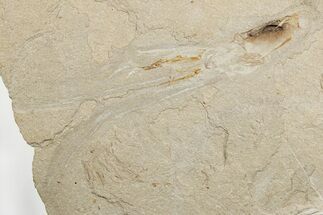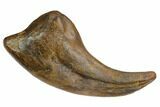This Specimen has been sold.
3.32" Oviraptor (Chirostenotes) Foot Claw - Hell Creek Formation
This
is a beautiful foot claw of the Oviraptor (Chirostenotes sp.) from the Hell Creek Formation of Carter County, Montana. It's approximately 3.32 inches long (straight line measure) and has a repaired crack near the tip and some restoration work done to the right (anatomically) side of the claw near the middle and at the proximal end.
Chirostenotes was a birdlike dinosaur, approximately 2 meters long and characterized by a toothless beak, long arms ending in slender relatively straight claws, long powerful legs with slender toes. It was probably an omnivore or herbivore which likely ate small reptiles and mammals, as well as plants, eggs and insects.
From Wikipedia:
"In 2005 Phil Senter and J. Michael Parrish published a study on the hand function of Chirostenotes and found that its elongated second finger with its unusually straight claw may have been an adaptation to crevice probing. They suggested that Chirostenotes may have fed on soft-bodied prey that could be impaled by the second claw, such as grubs, as well as unarmored amphibians, reptiles, and mammals. However, if Chirostenotes possessed the large primary feathers on its second finger that have been found in other oviraptorosaurs such as Caudipteryx, it would not have been able to engage in such behavior."
Chirostenotes was a birdlike dinosaur, approximately 2 meters long and characterized by a toothless beak, long arms ending in slender relatively straight claws, long powerful legs with slender toes. It was probably an omnivore or herbivore which likely ate small reptiles and mammals, as well as plants, eggs and insects.
From Wikipedia:
"In 2005 Phil Senter and J. Michael Parrish published a study on the hand function of Chirostenotes and found that its elongated second finger with its unusually straight claw may have been an adaptation to crevice probing. They suggested that Chirostenotes may have fed on soft-bodied prey that could be impaled by the second claw, such as grubs, as well as unarmored amphibians, reptiles, and mammals. However, if Chirostenotes possessed the large primary feathers on its second finger that have been found in other oviraptorosaurs such as Caudipteryx, it would not have been able to engage in such behavior."
SPECIES
Chirostenotes sp.
LOCATION
Carter County, Montana
FORMATION
Hell Creek Formation
SIZE
3.32" long
CATEGORY
SUB CATEGORY
ITEM
#129369
We guarantee the authenticity of all of our specimens.
 Reviews
Reviews













